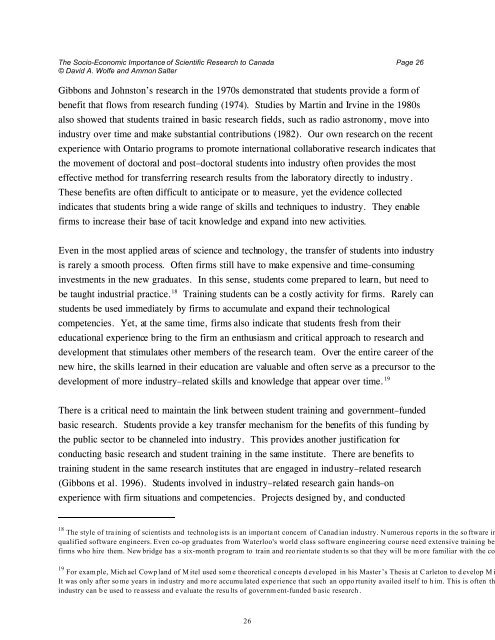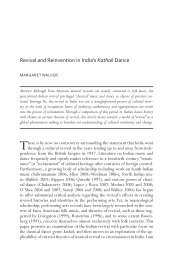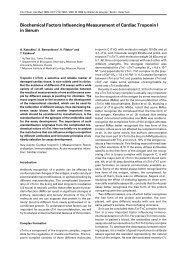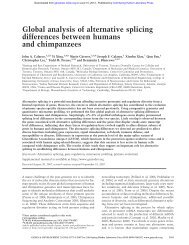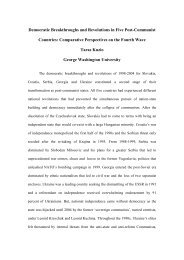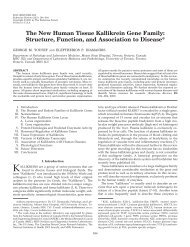The Socio-Economic Importance of Scientific Research To Canada
The Socio-Economic Importance of Scientific Research To Canada
The Socio-Economic Importance of Scientific Research To Canada
You also want an ePaper? Increase the reach of your titles
YUMPU automatically turns print PDFs into web optimized ePapers that Google loves.
<strong>The</strong> <strong>Socio</strong>-<strong>Economic</strong> <strong>Importance</strong> <strong>of</strong> <strong>Scientific</strong> <strong>Research</strong> to <strong>Canada</strong> Page 26© David A. Wolfe and Ammon SalterGibbons and Johnston’s research in the 1970s demonstrated that students provide a form <strong>of</strong>benefit that flows from research funding (1974). Studies by Martin and Irvine in the 1980salso showed that students trained in basic research fields, such as radio astronomy, move intoindustry over time and make substantial contributions (1982). Our own research on the recentexperience with Ontario programs to promote international collaborative research indicates thatthe movement <strong>of</strong> doctoral and post–doctoral students into industry <strong>of</strong>ten provides the mosteffective method for transferring research results from the laboratory directly to industry.<strong>The</strong>se benefits are <strong>of</strong>ten difficult to anticipate or to measure, yet the evidence collectedindicates that students bring a wide range <strong>of</strong> skills and techniques to industry. <strong>The</strong>y enablefirms to increase their base <strong>of</strong> tacit knowledge and expand into new activities.Even in the most applied areas <strong>of</strong> science and technology, the transfer <strong>of</strong> students into industryis rarely a smooth process. Often firms still have to make expensive and time–consuminginvestments in the new graduates. In this sense, students come prepared to learn, but need tobe taught industrial practice. 18 Training students can be a costly activity for firms. Rarely canstudents be used immediately by firms to accumulate and expand their technologicalcompetencies. Yet, at the same time, firms also indicate that students fresh from theireducational experience bring to the firm an enthusiasm and critical approach to research anddevelopment that stimulates other members <strong>of</strong> the research team. Over the entire career <strong>of</strong> thenew hire, the skills learned in their education are valuable and <strong>of</strong>ten serve as a precursor to thedevelopment <strong>of</strong> more industry–related skills and knowledge that appear over time. 19<strong>The</strong>re is a critical need to maintain the link between student training and government–fundedbasic research. Students provide a key transfer mechanism for the benefits <strong>of</strong> this funding bythe public sector to be channeled into industry. This provides another justification forconducting basic research and student training in the same institute. <strong>The</strong>re are benefits totraining student in the same research institutes that are engaged in industry–related research(Gibbons et al. 1996). Students involved in industry–related research gain hands–onexperience with firm situations and competencies. Projects designed by, and conducted18 <strong>The</strong> style <strong>of</strong> training <strong>of</strong> scientists and technologists is an important concern <strong>of</strong> Canadian industry. Numerous reports in the so ftware inqualified s<strong>of</strong>tware engineers. Even co-op graduates from Waterloo's world class s<strong>of</strong>tware engineering course need extensive training befirms who hire them. Newbridge has a six-month program to train and reorientate students so that they will be m ore familiar with the co19 For example, Michael Cowpland <strong>of</strong> M itel used some theoretical concepts developed in his Master’s <strong>The</strong>sis at Carleton to develop M iIt was only after some years in industry and more accumulated experience that such an oppo rtunity availed itself to him. This is <strong>of</strong>ten thindustry can be used to reassess and evaluate the results <strong>of</strong> governm ent-funded b asic research.26


